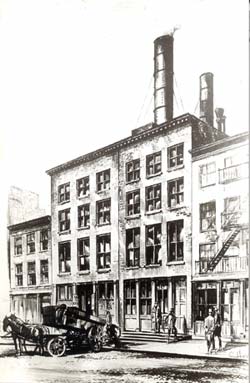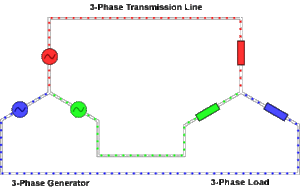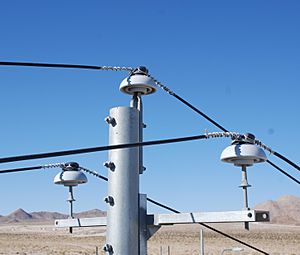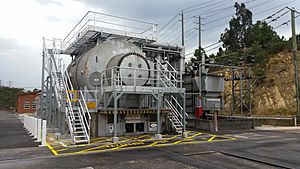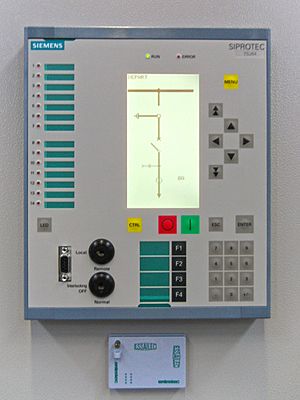Electric power system facts for kids
An electric power system is like a giant network of parts that work together to create, move, and use electricity. Think of the electrical grid that brings power to your home and local businesses. This huge grid has three main parts:
- Generators that make the electricity.
- The transmission system that carries power from where it's made to big cities.
- The distribution system that sends power from those cities to nearby homes and factories.
Smaller power systems are also found in places like factories, hospitals, and even your home. Most of these systems use three-phase AC power. This is the standard way to send and use electricity around the world. Special power systems, which don't always use three-phase AC, are found in airplanes, electric trains, ships, submarines, and cars.
Contents
How Electric Power Systems Started
In 1881, the world's first power system was built in Godalming, England. It used water wheels to make alternating current (AC) electricity. This power lit up some street lamps and light bulbs. But the power supply was not steady.
In 1882, Thomas Edison opened the first steam-powered electric power station in New York City. It was called the Pearl Street Station. This station first powered about 3,000 lamps for 59 customers. It made direct current (DC) electricity. DC power could not travel far without losing a lot of energy. So, generators had to be very close to where the power was used.
That same year in London, Lucien Gaulard and John Dixon Gibbs showed off the first "secondary generator." This was an early transformer. A transformer changes the voltage of electricity. In 1884, their transformer lit up 40 kilometers (about 25 miles) of railway from one AC generator. This showed that AC power could travel much farther than DC.
In 1885, three engineers, Ottó Titusz Bláthy, Károly Zipernowsky, and Miksa Déri, made the transformer even better. They gave it its modern name. They also created a power system that used several transformers connected in a new way. This system successfully lit over 1,000 lamps for months.
Also in 1885, an American businessman named George Westinghouse bought the rights to the Gaulard-Gibbs transformer. His engineer, William Stanley, improved the transformer design. In 1886, Stanley built an AC power system in Great Barrington, Massachusetts. This system powered many homes and businesses. It was not perfect, but it showed the potential of AC power. Later that year, Westinghouse started installing AC systems to compete with Edison's DC systems.
In 1888, Westinghouse got patents from Nikola Tesla for his AC induction motor and transformer designs. It took a few more years for Westinghouse engineers to create a working polyphase motor and transmission system.
By 1889, many power systems were built in the US and Europe. These systems mostly provided light. During this time, Edison and Westinghouse had a big rivalry. They argued about whether DC or AC power was better. This was called the "war of the currents."
In 1891, Westinghouse built the first major AC power system designed to power a large electric motor, not just lights. This was in Telluride, Colorado. In Europe, a long-distance (175 km or 109 miles) high-voltage AC line was built. It sent power from Lauffen am Neckar to Frankfurt am Main. This power lit lamps and ran a water pump.
The "war of the currents" ended when Edison's company merged with its main AC rival, forming General Electric. In 1895, AC was chosen as the standard for power transmission. Westinghouse built a large AC generating station at Niagara Falls. General Electric built the AC power system to supply Buffalo, New York.
Power systems kept improving after the 1800s. In 1936, the first experimental high voltage direct current (HVDC) line was built. HVDC sends DC power over very long distances at high voltages. In 1957, a new electronic device called a thyristor was invented. This device helped make power electronics much better. By the early 1970s, solid-state devices became standard in HVDC systems.
More recently, ideas from computers and communication technology have helped power systems. Computers make it easier to plan and manage power systems. Remote control systems now let engineers control power plants and equipment from far away.
How Electricity Works
Electric power is made from two things: current and voltage.
- Current is the flow of electric charge.
- Voltage is the "push" that makes the charge flow.
These can change over time (AC power) or stay constant (DC power).
Most refrigerators, air conditioners, and factory machines use AC power. Most computers and digital devices use DC power. If a digital device plugs into a wall outlet, it usually has a "power adapter" to change AC to DC.
AC power is good because it's easy to change its voltage. It can also be made and used by simple machines. DC power is best for digital systems. It can also be cheaper to send over very long distances at high voltages (HVDC).
Changing the voltage of AC power is important for two reasons: 1. Power can travel long distances with less loss at higher voltages. So, power is made at a low voltage, "stepped up" to a high voltage for travel, and then "stepped down" to a lower voltage near homes. 2. It's often cheaper to build generators that make high voltages. Transformers make it easy to change these high voltages to the lower voltages needed for appliances.
New electronic parts called solid-state devices can change DC power to different voltages. They can also change AC to DC power and back. But these devices can be more expensive. So, AC power is still widely used.
Parts of Power Systems
Power Sources
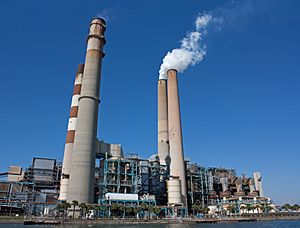
Every power system needs one or more ways to make electricity.
- DC power can come from batteries, fuel cells, or photovoltaic cells (solar panels).
- AC power usually comes from a turbo generator. This is a device where a spinning part (rotor) moves in a magnetic field.
Many things can make a turbine's rotor spin:
- Steam heated by burning fossil fuels (coal, gas, oil).
- Steam heated by nuclear energy.
- Falling water (hydroelectric power).
- Wind (wind power).
All generators connected to the same power grid spin at speeds that produce electricity at the same frequency (like 50 or 60 Hz). If more power is needed, the generators work harder. This means more fuel is used to make more electricity.
Loads

Power systems deliver energy to "loads." Loads are devices that use electricity to do something. These can be anything from your home toaster to big factory machines. Most loads need a certain voltage and, for AC devices, a certain frequency.
For example, home appliances usually use single-phase AC power. They work at 50 or 60 Hz with voltages between 110 and 260 volts. Larger air conditioners might use three-phase power because it's more efficient. Every electrical appliance also has a "wattage rating." This tells you how much power it uses.
A big challenge for power engineers is making sure the voltage, frequency, and amount of power are just right for all the loads. Also, many AC devices use an extra type of power called "reactive power." This power doesn't do useful work, but it flows back and forth in the system. Reactive power must also be balanced in the system. It can come from generators or from special devices called capacitors.
Sometimes, the power supply to a load isn't perfect. This can cause problems like voltage sags (when voltage drops briefly) or flickers. These "power quality" issues are very important for sensitive equipment, like in hospitals or factories.
Conductors
Conductors are the wires that carry electricity from generators to the loads. In a power grid, conductors are part of two main systems:
- The transmission system carries huge amounts of power at high voltages (over 69,000 volts) from power plants to major cities.
- The distribution system carries smaller amounts of power at lower voltages (under 69,000 volts) from those cities to homes and businesses.
The choice of conductor material depends on cost and how well it carries electricity. Copper used to be the main choice. But aluminum is now often used because it costs less for the same amount of power carried. Overhead power lines might have steel or aluminum alloys inside for strength.
Conductors can be placed overhead on poles or underground. Overhead wires are usually insulated by air and held up by ceramic or glass insulators. Underground cables and wires inside buildings have special plastic insulation. Wires are often made of many small strands twisted together. This makes them more flexible and easier to install.
Capacitors and Reactors
Most electrical loads in an AC power system are "inductive." This means the current flow is slightly delayed compared to the voltage. This delay creates "reactive power." Reactive power doesn't do useful work, but it flows back and forth in the system.
Generators can provide reactive power. But it's often cheaper to use capacitors. Capacitors are often placed near loads that need reactive power. This helps the power system work more efficiently.
Reactors are devices that use reactive power. They help control voltage on long transmission lines. They can also limit sudden rushes of current. Small reactors are often used with capacitors to control current when capacitors are turned on.
Power Electronics
Power electronics are special devices made from semiconductors. They can switch large amounts of power very quickly. This allows them to do many tasks that older technology couldn't.
One common use is "rectification." This is changing AC power to DC power. You'll find power electronics in almost every digital device that plugs into a wall outlet. They are either in the power adapter or inside the device.
High-power electronics are also used in HVDC systems. These systems convert AC power to DC power for very long-distance transmission. HVDC is often more economical for hundreds or thousands of kilometers. It also helps make power grids more stable. Power electronics are also key for solar panels, which produce DC power but often need to connect to an AC grid.
Power electronics are also found in:
- All modern electric and hybrid cars, for motor control and other functions.
- Most modern gasoline cars, to recharge the battery and power accessories.
- Some electric railway systems, to feed power to trains and control their speed.
- Many industrial machines, for motor control and starting circuits.
- Modern air conditioners and variable speed wind turbines.
Protective Devices
Power systems have safety devices to prevent harm or damage during problems.
- Fuses are common protective devices. If too much current flows through a fuse, a special wire inside melts. This breaks the circuit and stops the current. Fuses protect equipment from damage. However, once a fuse melts, it must be replaced. Also, fuses might not stop current fast enough to protect a person from a deadly shock.
- Circuit breakers solve the problem of needing to replace fuses. They can be reset after they stop current flow. In homes, small circuit breakers are used. They sense too much current and automatically open the circuit.
- In larger power systems, special devices called protective relays detect a problem. They then tell a separate circuit breaker to open. Modern relays are like small computers. They decide when to trip based on readings from the power system. Large circuit breakers use special gases, like sulfur hexafluoride (SF6), to quickly stop the electric arc that forms when the circuit opens.
- Residual-current devices (RCDs) are very important for safety. In a working appliance, the current flowing in should equal the current flowing out. An RCD watches these currents. If it sees a difference (meaning current is leaking, perhaps through a person), it quickly shuts off the power. RCDs are common in homes and help prevent electric shocks.
SCADA Systems
In large electric power systems, a system called supervisory control and data acquisition (SCADA) is used. SCADA helps engineers:
- Turn generators on and off.
- Control how much power generators produce.
- Switch parts of the system on or off for maintenance.
Early SCADA systems had simple panels with lights and switches. Today, SCADA systems are very advanced. Engineers can control power plants from far away using computers. Because these systems are so important, keeping them secure from cyber-attacks is a big concern.
Power Systems in Real Life
Even though they share common parts, power systems are designed and operated differently depending on their use.
Home Power Systems
Homes usually get electricity from low-voltage distribution lines. These lines carry power at voltages between 110 and 260 volts. Years ago, small homes might have had one main wire coming in. This wire would go through a main switch in the fuse box. Then, it would split into separate circuits for lights and appliances. Lights and appliances were kept separate so that if an appliance failed, the lights would still work.
Modern home wiring has changed for safety and convenience:
- Most homes now use miniature circuit breakers instead of fuses. These are easier to reset.
- RCDs are often installed on appliance and lighting circuits for extra safety.
- Larger, centralized air conditioners that need three-phase power are becoming more common.
- Protective "earth" wires are now run with lighting circuits. This helps ground metal light fixtures.
- More homes are adding small power generators, like photovoltaic cells (solar panels).
Commercial Power Systems
Commercial power systems, like those in shopping centers or tall buildings, are much larger than home systems. Their electrical designs are carefully planned to ensure enough power, prevent short circuits, and manage voltage drops. They also have special protective devices. Large commercial buildings have many "sub-panels" to organize and protect the electrical system better.
In hot places, the heating, ventilation, and air conditioning (HVAC) unit is often the biggest user of electricity. Making sure it gets enough power is a key part of commercial system design. Commercial buildings also have to follow special rules. For example, they might need emergency lighting that stays on for a certain time if the main power goes out. They may also have rules for emergency power, smoke control, and fire protection.
Managing Power Systems
How a power system is managed depends on its size. Small systems, like in a car, might just run until something breaks. In airplanes, power systems have backup parts (redundancy) to make sure they always work. Larger power systems need active management.
Dealing with Problems
"Fault management" means watching the power system to find and fix problems that affect its reliability. This can be fixing a specific issue, like a power line knocked down by a storm. Or it can be making system-wide improvements, like adding devices that automatically restore power after a brief outage.
Upkeep and Upgrades
Power systems need regular maintenance and sometimes upgrades. It's often not practical to turn off large parts of the system for this work. So, power systems are built with many switches. These switches allow engineers to turn off only the part they are working on, while the rest of the system stays on. At high voltages, there are two main types of switches: isolators and circuit breakers. Circuit breakers can open a circuit while power is flowing. Isolators cannot be opened when power is flowing, as this would cause dangerous sparks. For planned work, circuit breakers are opened first, then isolators are opened to safely disconnect the area. This allows work to be done without shutting down the whole system.
Frequency and Voltage Control
One of the biggest challenges in power systems is making sure that the amount of power used (plus any power lost) always equals the amount of power being made. If less power is used but generators keep making the same amount, the generators will spin faster, and the system's frequency will go up. If more power is used, the frequency will go down.
So, the system frequency must be actively managed. This is done by turning generators on or off, or by controlling how much power they produce. A "system operator" usually handles this. They also make sure:
- Customers and equipment get the right voltage.
- Reactive power transmission is kept low for efficient operation.
- Teams are sent out to fix any problems.
- Remote switches are used to allow for system work.
See also
 In Spanish: Sistema eléctrico de potencia para niños
In Spanish: Sistema eléctrico de potencia para niños


